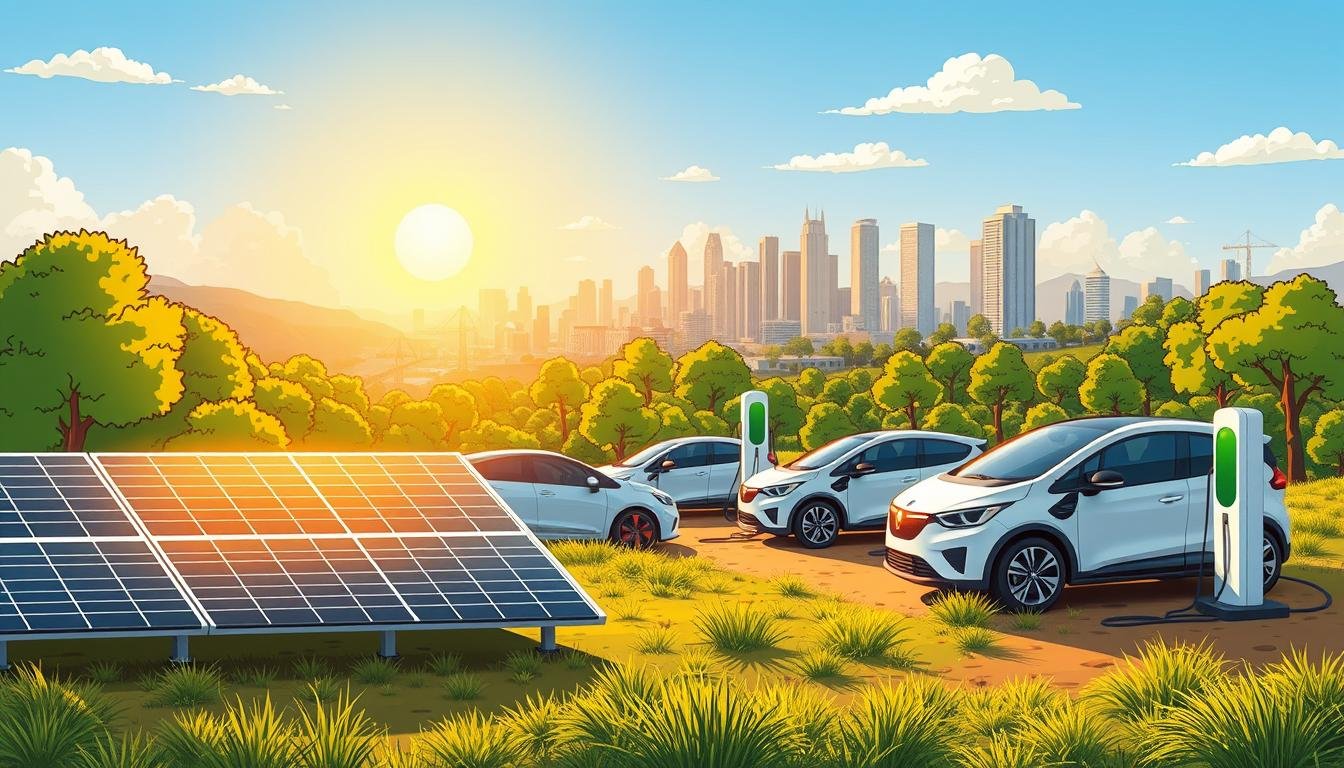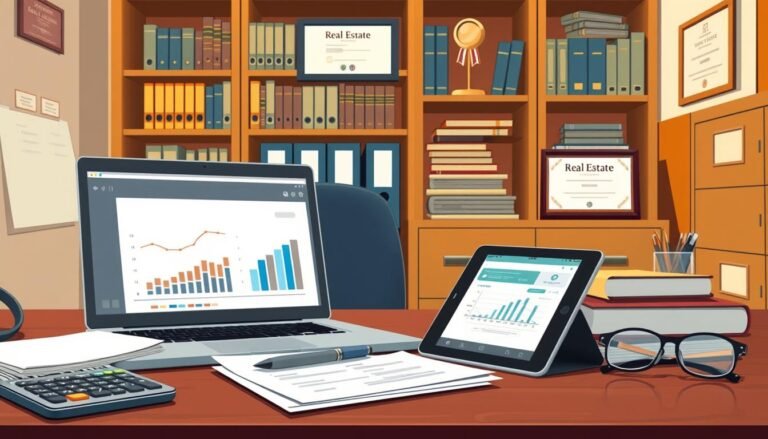Green financing options
Green financing is changing how we fund projects that help the planet. It uses money for renewable energy, cleaner infrastructure, and eco-friendly ideas. This includes solar panels and electric vehicle upgrades, helping to cut down on carbon emissions and boost the economy.
For example, green bonds helped the Province of Ontario upgrade public transit. This move cut emissions and created jobs. Companies like EDC provide green loans for wind farms or energy-efficient buildings. Even small businesses can get green promissory notes for small sustainability projects.
Key Takeaways
- Green financing reallocates funds to projects like renewable energy and pollution control.
- Options include green bonds, loans, and tax incentives for solar or electric vehicle purchases.
- Over 80% of investors now seek sustainable financial solutions that align with climate goals.
- Programs like the Department of Energy’s loan initiatives lower barriers for adopting clean energy.
- Frameworks like TCFD and PCAF ensure transparency in tracking environmental impact.
As climate challenges grow, businesses and households are turning to these tools. But how do these choices stack up against traditional finance methods? This article explores how green financing bridges the gap between ecological needs and practical money management.
Understanding Green Financing
Green financing is more than a trend; it’s a big change in how money is used. This part explains what eco-conscious funding is and why it’s important. You’ll learn about the key players making this shift happen and how they’re changing finance.
What Makes Financing “Green”
Projects are green if they help the environment. Green financing options focus on things like clean energy, green transport, or farming that’s good for the planet. Rules like the Green Bond Principles make sure everything is clear. For instance:
- Renewable energy installations
- Waste reduction programs
- Low-emission infrastructure
The Growing Importance of Sustainable Finance
More people want eco-conscious funding now. Investors look at ESG (Environmental, Social, Governance) factors, which has led to big moves like Apple’s $4.7B in green bonds for solar and EV projects. Governments and banks work together to create loans and rules that help the planet. They also support small businesses and check if rules match climate goals.
Key Players in the Green Financing Ecosystem
| Key Player | Role |
|---|---|
| UN Environment Programme | Guides policy reforms for sustainable practices |
| World Bank | Funds large-scale renewable energy projects |
| JPMorgan Chase | Offers green loans and sustainability-linked bonds |
| U.S. Department of Energy | Administers grants and loans for clean energy |
These groups work together to make green financing options bigger. They make sure money goes to projects that are good for both profits and the planet.
Benefits of Choosing Eco-Conscious Funding
Eco-conscious funding turns caring for the environment into chances to help both the planet and our wallets. It makes financial goals and global climate targets match, helping everyone win.
Environmental Impact Benefits
Projects backed by sustainable finance cut down on carbon emissions and protect nature. Solar farms reduce coal use, and reforestation brings back habitats. These efforts help meet global climate goals and lower emissions.
Financial Advantages for Borrowers
Lower interest rates and tax breaks make eco-friendly funding easier to get. For example, solar panel loans often have federal incentives, reducing costs. Companies going green also attract investors looking for sustainable finance initiatives, making them more appealing in the market.
Long-term Economic Returns
Energy-efficient buildings can save 20–30% on bills every year. Jobs in renewable energy have grown 3% yearly since 2015, beating traditional sectors. Communities get strong infrastructure, protecting them from rising carbon taxes and fines.
Green Financing Options for Homeowners
Homeowners looking for green energy financing can check out the GoGreen Home Energy Financing initiative. This environmentally friendly loans program offers flexible terms for upgrades like solar panels, heat pumps, and insulation. Loans range from $1,000 to $75,000 with APRs starting at 3.75%.
These loans are available through credit unions like California Coast Credit Union and Desert Valleys Federal Credit Union.
Loans cover solar + battery storage, EV chargers, and weatherization. No collateral or closing costs are needed, and preapproval is quick, in 24 hours. The program grew in 2023 to include modern tech like battery storage systems.
Homeowners in certain counties can also use PACE financing or Energy-Efficient Mortgages (EEMs). An energy rating (HERS or DOE) is needed to qualify. A lower HERS score (0-150) means better efficiency, leading to better loan terms.
Upgrades like LED lighting or triple-pane windows can also boost ratings and loan options. Renewable energy projects and insulation upgrades qualify. The DOE Home Energy Score evaluates older homes, while HERS certifies new builds.
Reports show annual energy savings, helping homeowners plan budgets. With terms up to 20 years, these loans make eco-friendly upgrades affordable. Tenants in eligible areas may also apply for specific upgrades. Explore these programs to cut utility bills and increase home value—all while protecting the planet.
Environmentally Friendly Loans: How They Work
Environmentally friendly loans help fund projects that lessen environmental damage. They follow the International Capital Market Association’s (ICMA) Green Loan Principles. These sustainable financial solutions have grown to over $4.18 trillion worldwide, with a 21% annual growth rate expected. Here’s how they work:
- Use of Proceeds: Money goes straight to green projects like solar panels or energy-saving buildings.
- Project Evaluation: Projects are carefully checked to make sure they’re green.
- Management of Proceeds: Lenders make sure the money is only used for green projects.
- Reporting: Borrowers report yearly on how their projects are doing and if they’re following the rules.
Green Mortgages
These loans help people buy or improve homes that save energy. If a home uses green materials or systems, the borrower might get a lower interest rate. For instance, a loan could help install energy-saving windows or a geothermal system, increasing the home’s value and saving on energy bills.
Home Energy Renovation Loans
Renovation loans fund upgrades like better insulation, smart thermostats, or new HVAC systems. Borrowers can choose how long to pay back the loan, and the money can only be used for approved improvements. Before approving, lenders check if the upgrades meet ENERGY STAR or LEED standards.
Solar Panel Financing
Solar loans help homeowners pay for solar panel installations over 5 to 20 years. Many programs offer tax credits, making the upfront cost lower. Unlike leases, loans let homeowners own the panels after paying off the loan, making it a long-term investment in savings and sustainability.
Business-Focused Sustainable Financial Solutions
Small businesses and big corporations can do well with sustainable financial solutions that match their green goals. Over 90% of small and medium-sized enterprises worldwide struggle to go green. But now, new programs help them make the switch.
Loans like sustainability-linked financing adjust interest rates based on green achievements. This approach encourages businesses to move forward while saving money.
Government-backed loans, like the SBA 7(a) loan and USDA’s REAP fund, support clean energy and green infrastructure. California’s PACE program uses bonds to finance green upgrades, repaid through property taxes. These options help businesses invest without needing a lot of cash upfront.
There are many ways to invest in the environment:
- Green bonds and impact investing for big projects
- Private equity and venture capital for eco-startups
- Green leasing for energy-saving equipment at good rates
Green finance has grown from $5.2 billion in 2012 to over $540 billion in 2022. This growth is due to the increasing demand for clean energy and sustainability. Companies like Trine and Clim8 offer ways to invest in solar and water tech. Aspiration and TreeCard provide banking services that support tree planting and reforestation.
By using these strategies, businesses can save money, meet environmental rules, and attract customers who care about the planet. Studies show that green loans can cut energy costs by up to 40%. This makes businesses more resilient in the long run. Start looking into these options to make your finances and the planet healthier together.
Green Bonds and Climate-Aligned Investments
Green bonds and climate-aligned loans are changing how we fund sustainable projects globally. These tools, backed by standards like the Green Bond Principles (GBP), support renewable energy and clean transport. Since 2007, over $521 billion has been raised, showing their impact on eco-friendly investments.

Corporate Green Bonds
Companies issue corporate green bonds for projects like solar farms or energy-saving factories. For example, Fannie Mae raised $20.1 billion in 2018 for green housing. The 2021 GBP guidelines and 2023 Checklist ensure these projects meet environmental and social goals. They also require third-party checks to confirm their climate benefits.
Municipal Climate Bonds
Local governments issue municipal climate bonds for projects like public transit or green infrastructure. In 2018, the U.S. led with $34.2 billion in funding for urban renewal and clean energy. Asia-Pacific regions grew 35% yearly, while Europe had the biggest market share. These bonds help make cities more climate-resilient, meeting global climate goals.
Green Investment Funds
Investors can invest in eco-friendly projects through funds like ETFs or mutual funds. These funds focus on projects that meet GBP standards, offering a mix of green energy and sustainability. In 2018, 204 new issuers brought in $61.2 billion. These funds make it easy for people to support projects like wind farms or carbon-cutting programs.
Federal Green Financing Programs in the United States
U.S. federal agencies offer green financing options and sustainable finance initiatives
Department of Energy Loan Programs
The Department of Energy (DOE) has a Loan Programs Office (LPO). It provides funding for:
- Loan guarantees for sustainable finance initiatives like solar farms and carbon capture systems
- Advanced Technology Vehicles Program: Funds electric vehicle manufacturing and infrastructure
- Tribal Energy Program: Supports renewable projects on tribal lands
- Carbon Transport Loans: Finance infrastructure for carbon capture and storage
- Title 17 Program: Provides direct loans for legacy energy infrastructure upgrades
EPA Funding Opportunities
EPA programs focus on environmental restoration and community development. These green financing options include:
- Brownfields Program: Funds contaminated land cleanup and redevelopment
- Clean Water State Revolving Fund: Supports water infrastructure improvements
- Environmental Justice grants for underserved communities
USDA Rural Development Programs
The USDA offers grants and loans for rural sustainability:
- Rural Energy for America Program (REAP): Funds renewable energy systems and efficiency upgrades
- Rural Business-Cooperative Service loans for eco-friendly infrastructure
- Single-Family Housing Energy Efficiency grants
| Program | Agency | Type | Focus Area |
|---|---|---|---|
| Loan Programs Office (LPO) | DOE | Loans/ Guarantees | Clean energy, carbon capture |
| Brownfields Program | EPA | Grants | Contaminated site redevelopment |
| REAP | USDA | Grants/Loans | Rural renewable energy |
| SBA 7(a) Loans | SBA | Loans | Small business eco-projects up to $500k |
Learn more about these programs on agency websites or through partner lenders. Contact the DOE, EPA, or USDA for application details and eligibility.
State-Level Incentives and Financing Options
Looking into green financing options isn’t just about federal programs. Many states have their own sustainable finance initiatives for renewable energy and energy efficiency. For example, California’s Property Assessed Clean Energy (PACE) program helps commercial property owners pay for solar panels or insulation upgrades through property taxes. This way, big projects become more manageable.
In states like New York and Connecticut, green banks use public funds to draw in private investors for clean energy projects. Illinois offers tax breaks for data centers that follow green building standards. Arizona and Texas have solar tax credits and rebates. Homeowners can even sell Solar Renewable Energy Certificates (SRECs) to utilities, making money from their energy savings.
Here’s a comparison of key state programs to help you find what’s available in your area:
| State | Program | Incentive Type | Description |
|---|---|---|---|
| California | CaliforniaFIRST | Grants & Rebates | Reduces costs for energy efficiency upgrades in businesses and multifamily housing. |
| New York | NYSERDA | Loans & Grants | Offers financing for renewable energy projects, including solar and wind installations. |
| Connecticut | Green Bank | Public-Private Partnerships | Levers state funds to mobilize private capital for solar, energy storage, and electric vehicle infrastructure. |
| Illinois | Data Center Tax Exemptions | Tax Credits | Reduces costs for facilities using energy-efficient cooling systems like liquid immersion cooling. |
Programs differ a lot. Use resources like the Database of State Incentives for Renewables & Efficiency (DSIRE) to find rebates, tax breaks, or grants in your area. Whether you’re a homeowner or business owner, these sustainable finance initiatives can make energy upgrades affordable and profitable.
Green Energy Financing: Solar, Wind, and Beyond
Looking into green energy financing opens up opportunities for all kinds of clean energy projects. Homeowners can get a 30% tax credit for solar panels, small wind turbines, and geothermal systems. This tax break is available until 2032.
Power Purchase Agreements (PPAs) Simplified
PPAs make it easy for homes and businesses to use renewable energy without paying upfront. The company installing the system takes care of it, and users pay a set rate for the energy. Here’s how PPAs compare to loans:
- No initial cost to install solar panels
- Fixed energy rates protect against utility price spikes
- Available for commercial rooftops and agricultural sites
Community Solar Financing Models
Community solar programs let people invest in solar farms together. You can buy shares of a local array and get credits on your electricity bill. Now, over 30 U.S. states offer these programs, making solar more accessible.
| Financing Type | Description | Key Benefits |
|---|---|---|
| Green Bonds | Fixed-income investments funding wind/solar projects | Stable returns + environmental impact tracking |
| Revenue-Based Loans | Repayments tied to project-generated income | Flexible repayment schedules |
| PACE Financing | Property-secured loans for energy upgrades | Long repayment terms (10–20 years) |
New technologies like offshore wind farms and hydrogen storage are now part of eco-friendly investments. Companies like Ørsted and NextEra Energy are leading the way. The requirements for these loans vary, but they’re available for those with good credit.
Real examples show that clean energy projects can save money and help the planet. Binns Martial Arts, for instance, cut their energy costs by 40% with green loans. Theseeco-friendly investment strategiesshow that clean energy can be both good for the planet and profitable.
How to Qualify for Eco-Friendly Financial Solutions
To get eco-friendly loans or investment strategies, you need to meet certain criteria. Lenders look for projects that help the environment and are financially sound.
Eligibility Requirements
Projects must meet green standards. For instance:
- Commercial loans need certifications like LEED for buildings
- Home loans require Energy Star-rated appliances or solar installations
- Businesses must show reduced carbon footprints
Documentation Needed
| Document Type | Example | Use |
|---|---|---|
| Environmental audit | Third-party energy efficiency report | Proves green project viability |
| Property proof | Deed or lease agreement | Validates ownership for secured loans |
| Project plan | Solar installation blueprints | Shows compliance with green criteria |
Credit Considerations
Many programs offer flexibility. Valley Credit Union accepts:
- Credit scores as low as 620 with cosigners
- Debt-to-income ratios up to 50% for energy-saving projects
- Alternative metrics like projected energy savings
Start by reviewing the World Bank’s green loan criteria. Compare offers from at least three lenders. Early planning and clear documentation increase your chances of approval.
Navigating the Application Process for Green Funding
Getting green financing options means being well-prepared. First, look for banks or credit unions that focus on climate-aligned loans. The GreenBiz directory is a great tool to find these lenders.
- Align Your Project: Show how your project helps the environment. Talk about goals like adding solar panels or making buildings more energy-efficient.
- Prepare Documentation: Collect reports on your project’s environmental impact, budgets, and any certifications. Banks want to see you’re serious about being green.
- Optimize Your Proposal: Make sure your project makes financial sense. Show how green upgrades save money in the long run. Include a 5-year plan for returns.
- Seek Expert Help: Sustainable finance advisors can make your proposal stronger. The SBA offers free help for small businesses looking for eco-friendly loans.
Avoid mistakes like missing data or unclear goals. If you’re turned down, ask for feedback and improve your plan. Keep up with new grant chances on Energy.gov.
Remember, lenders want to see real results. Show them how your project will save energy or reduce waste. Being persistent and well-prepared can help you get the funding you need.
Measuring the Impact of Your Sustainable Financing
Tracking results is key to proving the value of sustainable financial solutions. Whether you’re a homeowner or business, knowing how to measure impact ensures your investments align with eco goals and financial health.
Environmental Performance Metrics
Start by tracking data like carbon emissions, energy use, and water savings. For example, solar projects might show yearly reductions in greenhouse gases. Tools like the Task Force on Climate-related Financial Disclosures (TCFD) help standardize reporting. Use metrics tied to your project’s goals—like biodiversity gains for land restoration efforts.
Financial Return on Investment
Calculate savings from lower energy bills or tax incentives. Sustainable finance initiatives often cut long-term costs. For instance, energy-efficient buildings may boost property value over time. Compare initial costs to decades of savings to see true ROI.
Reporting Requirements for Funded Projects
Transparency builds trust. Reports must follow frameworks like the Green Bond Principles. Share progress on emissions cuts and financial outcomes. Disclose data even if results fall short—it shows accountability. Use third-party audits to verify claims and meet legal standards like B-15.
Overcoming Common Barriers to Green Financing
Small businesses and startups often find it hard to get eco-conscious funding. This is because of missing data and limited resources. A global survey found that 80% of emerging markets face challenges with climate data and project viability.
- Start with green energy financing tools like government grants or energy efficiency loans. Programs like the USDA Rural Development grants help reduce costs for renewable installations.
- Build partnerships with local banks or NGOs to share risk assessments. Mexico’s mangrove restoration projects cut flood damage costs by 70% while attracting international investors.
- Use clear metrics to prove impact. Track energy savings or carbon reductions to qualify for tax incentives under IRS Section 45L for geothermal systems.
| Traditional Methods | Nature-Based Solutions (NbS) |
|---|---|
| Cost: $10M+ | Cost: $2.5M |
| 5-10 years ROI | 3-5 years ROI |
| Steel seawalls | Mangrove restoration |
Despite these efforts, 40% of climate projects in developing nations still lack funding. Yet, success stories like Indonesia’s solar microgrids show that combining green energy financing with community engagement boosts approval rates. Start small: retrofitting 25% of operations first can build a track record for larger loans. Every step toward sustainability today paves the way for bigger opportunities tomorrow.
Conclusion: Taking the First Step Toward Sustainable Funding
Green financing options are now a key part of building a sustainable future. Solutions like green mortgages and loans from Fundingo help businesses and homeowners. They can get funding for solar panels and energy upgrades.
These green financing options reduce emissions and save money. They also help manage risks better. This makes businesses more profitable.
In 2020, over $269.5 billion in green bonds were issued worldwide. This shows sustainable finance initiatives are growing. Starting small or big, every step is important.
Fundingo offers competitive loans and advice. Green bonds fund climate-positive projects directly. This helps businesses grow sustainably.
Businesses can start by looking at federal programs or state incentives. They should assess their needs and get expert advice. Each choice, like solar panels or green bonds, makes them more resilient.
It’s a smart move for the future. It’s not just right—it’s strategic. Every step counts, from small upgrades to big investments.
Begin with a simple step today. Upgrading, getting a green loan, or investing in green infrastructure matters. You’ll be part of a community making a difference. The tools are ready; it’s time to use them.
Source Links
- Where Can You Find Green Financing For Your Business? – https://greenly.earth/en-us/blog/industries/where-can-you-find-green-financing-for-your-business
- A Roadmap to Green Financing and Carbon Management in 2025 – https://www.arbor.eco/blog/a-roadmap-to-green-financing-and-carbon-management-in-2024
- Green Financing – https://www.unep.org/regions/asia-and-pacific/regional-initiatives/supporting-resource-efficiency/green-financing
- Green Finance: Green Bonds, ESG and Other Ways – https://vasscompany.com/en/insights/blogs-articles/green-finance/
- Green Funding: Financing Your Eco-Friendly Venture – https://www.thefundingfamily.com/blog/green-funding
- Green Financing: The Basics of Sustainable Investment – https://www.wealthformula.com/blog/green-financing-the-basics-of-sustainable-investment/
- What is Green Financing & Its Importance for Sustainable Future – https://www.sganalytics.com/blog/green-financing/
- CAEATFA GoGreen Home Energy Financing – https://www.treasurer.ca.gov/caeatfa/cheef/reel/index.asp
- Find California Energy Financing | GoGreen Financing – https://www.gogreenfinancing.com/energy-efficiency-home-loans-california/finance-options/
- Financing Energy-Efficient Homes – https://www.energy.gov/energysaver/financing-energy-efficient-homes
- Green loans: Financing a greener earth. – https://www.comundo.io/blog-posts/green-loans
- What Is a Green Loan? – https://www.investopedia.com/what-is-a-green-loan-8696296
- Sustainable Business Practices and Green Financing: A Guide for Small Businesses – Small Business Bank – https://www.smallbusinessbank.com/sustainable-business-practices-and-green-financing/
- Top 10 Sustainable Finance Companies | DashDevs – https://dashdevs.com/blog/top-10-fintech-companies-that-worship-sustainability-social-change/
- Green Bond Principles » ICMA – https://www.icmagroup.org/sustainable-finance/the-principles-guidelines-and-handbooks/green-bond-principles-gbp/
- PDF – https://www.climatebonds.net/files/reports/cbi_gbm_final_032019_web.pdf
- FINANCING PROGRAMS – https://www.energy.gov/lpo/financing-programs
- Biden-Harris Administration Opens SBA Loan Programs to New Green Lenders to Help Small Businesses Meet Climate Goals – https://www.sba.gov/article/2024/07/22/biden-harris-administration-opens-sba-loan-programs-new-green-lenders-help-small-businesses-meet
- How solar financing & incentives can help you go green – ENACT – https://enact.solar/how-solar-financing-incentives-can-help-you-go-green/
- Did You Know There Are Government Incentives for Going Green? – https://www.grcooling.com/blog/know-government-incentives-switching-green/
- Green Energy Financing and Its Role in Lowering Carbon Emissions — Green and Prosperous – https://www.greenandprosperous.com/blog/green-energy-financing-and-its-role-in-lowering-carbon-emissions
- Green Energy Financing | Biz2Credit – https://www.biz2credit.com/green-energy-financing
- Green Finance: Investing With Sustainability in Mind | JWU CPS – https://online.jwu.edu/blog/green-finance-investing-with-sustainability-in-mind/
- Valley Credit Union – Green Lending: How to Finance Eco-Friendly Home Improvements – https://www.valleycu.org/Blog/Financial-Tips/January-2025/green-loans-for-home-improvements
- Greening Finance: Navigating the Transformative Landscape of Eco-Friendly Loans – https://medium.com/@lokeshbohra/greening-finance-navigating-the-transformative-landscape-of-eco-friendly-loans-477486c5f913
- Green Financing: Definition, Benefits, and How to Access It – https://mekari.com/en/blog/green-financing/
- Measuring the impact of green banking practices on banks’ environmental performance and sources of green financing: a study on Indian banks – Discover Sustainability – https://link.springer.com/article/10.1007/s43621-024-00678-5
- Impact Measurement and Management in Sustainable Finance – https://www.adb.org/sites/default/files/institutional-document/691951/ado2021bp-measurement-mgt-sustainable-finance.pdf
- Challenges of Green Finance: Private Sector Perspectives from Emerging Markets – https://www.ifc.org/content/dam/ifc/doc/2023/challenges-of-green-finance.pdf
- 5 Barriers That Hinder Green Financing – https://www.wri.org/update/5-barriers-hinder-green-financing
- Green Finance – Options, Strategies and Challenges – https://www.linkedin.com/pulse/green-finance-options-strategies-challenges-kannan-r
- Go Green with Renewable Energy Financing Fundingo s Solutions for Eco Friendly Loans – Loan Management Software by Fundingo – https://www.fundingo.com/go-green-with-renewable-energy-financing-fundingo-s-solutions-for-eco-friendly-loans/
- The Challenges of Green Finance – https://greenly.earth/en-us/blog/industries/how-can-you-make-the-change-to-green-finance
- Green Bonds for Financing Renewable Energy – https://www.thefundingfamily.com/blog/green-bonds-for-financing








